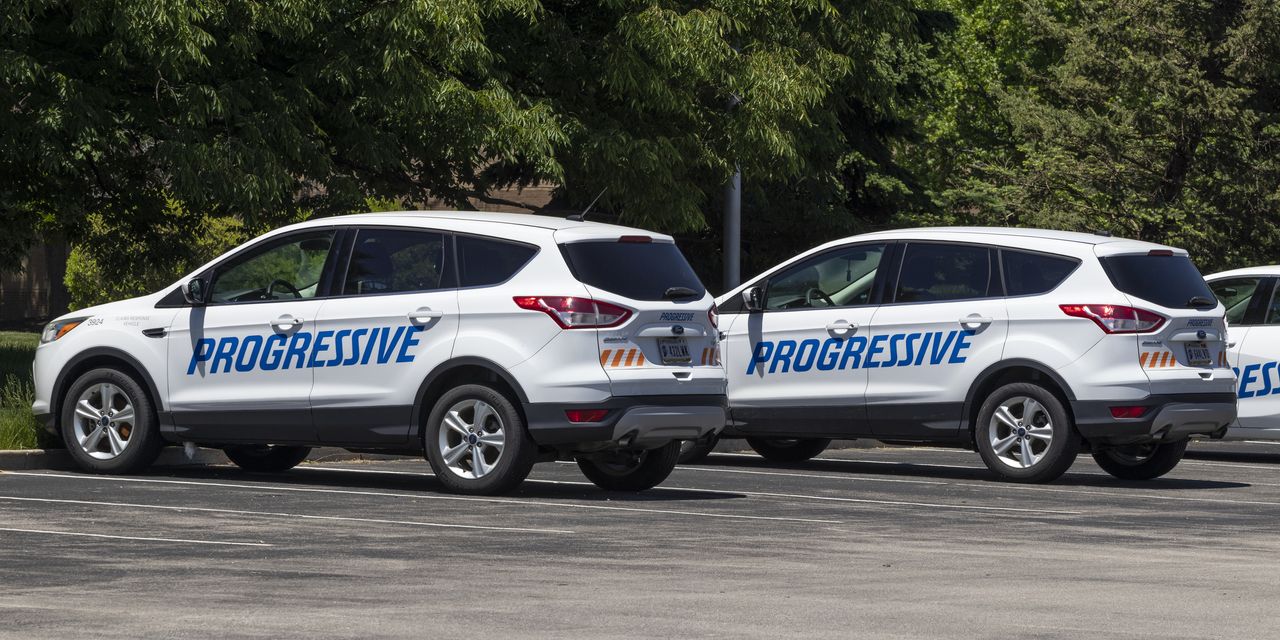
Progressive managed to stay in the black while other auto insurers racked up big losses.
Dreamstime
Auto insurers have been scrambling to raise prices to offset big underwriting losses and the impact was visible in the report on U.S. consumer prices earlier Tuesday.
Auto insurance prices rose 1.6% in February and were up 14.5% in the past 12 months, one of the larger annual increases of any category in the CPI report (auto insurance has a 2.5% weighting in the index).
The car insurance industry prospered during 2020 when the Covid pandemic reduced driving activity—and accidents. But things turned south in 2022 because of the inflation in labor, parts, used cars and rental cars.
All the major auto insurers except Progressive (Ticker PGR) reported sizable underwriting losses during 2022. The worst results were generated by the top auto insurer, State Farm, which had an underwriting loss of $13.4 billion on premium revenue of $45.7 billion.
That resulted in a combined ratio—expenses and losses divided by premium revenue—of nearly 130%. That is a high ratio and rare for such a large auto insurer. Most auto insurers had combined ratios of 110% or less in 2022, meaning their underwriting losses were 10% or less. Auto insurers—and insurers generally—seek to produce annual underwriting profits. They also generate additional income from investments, mostly bonds.
A State Farm spokesman said the company, which is owned by policyholders, is “financially strong and remains focused on helping millions of our customers recover from the unexpected.” State Farm Auto’s net worth stood at $131 billion at the end of 2022.
Allstate,
the No. 4 auto insurer, had an underwriting loss of 10% in 2022 (a combined ratio of 110) while Geico, the No. 2 insurer, had an underwriting loss of 5%, or $1.9 billion, last year but expects to turn a profit in 2023. Progressive, the third-largest insurer, remains the industry outlier with an underwriting profit margin of 4%.
Progressive, which is viewed as the best-managed auto insurer, was quicker to raise rates than its peers and has been in a position to expand while rivals like Geico were shrinking their number of insured motorists. Progressive raised auto insurance rates by 13% in 2022.
“We know that our competitors are raising rates to address their own profitability concerns, and as they have done so, we’ve seen our relative competitiveness improve, which has resulted in improving retention, strong quote growth, and high conversion,” Tricia Griffith, Progressive’s CEO, said at the company’s investor event on Feb. 28. Progressive’s goal is to grow as rapidly as practicable as long as its underwriting profit margin is 4% or better—which it has been.
The focus of the meeting was the company’s leadership in telematics, or using real-time information from drivers about such factors as acceleration, braking, time of day and mileage to price policies.
Progressive shares have been a standout this year and over the past 12 months. The stock, at around $142, is up 9% in 2023 and 34% higher over the past year. Travelers (TRV) is down 8% in 2023 at $171.76 and Allstate is off 7% this year to $114.
BofA Securities analyst Josh Shanker recently lifted his price target on Progressive to $179 while maintaining a Buy rating. He wrote Progressive, which grew its auto policy count by 3% in January to more than 10 million, could see growth “accelerate as competitors scramble to raise prices amid persistent underwriting losses.”
Progressive trades for more than 20 times projected 2023 earnings, one of the higher valuations among big financial stocks—the company has a market value of $82 billion. Progressive trades for five times book value. Other big insurers trade for 10 to 16 times estimated 2023 earnings and for usually no more than twice book value. Shanker sees Progressive’s profits rising to nearly $10 a share next year from around $7.50 in 2023.
Write to Andrew Bary at [email protected]




![[Toyota Times] From Strengthening Foundations to Boosting Productivity – Toyota Focuses on Break-Even Volume [Toyota Times] From Strengthening Foundations to Boosting Productivity - Toyota Focuses on Break-Even Volume](https://businessfortnight.com/wp-content/uploads/2025/11/Toyota-Times-From-Strengthening-Foundations-to-Boosting-Productivity-Toyota-218x150.jpg)





























